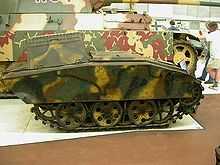Springer (tank)

The Springer (complete name: Mittlerer Ladungsträger Springer, Sd.Kfz. 304) was a demolition vehicle of the German Wehrmacht in World War II.
Description
Based on the well-known NSU Kettenkrad, the NSU Werke AG at Neckarsulm, Germany, developed and built around 50 Springer demolition vehicles in the final year of World War II.
To make the vehicle capable of carrying a bigger payload without the motorcycle-style front fork, two pairs of overlapping and interleaved road wheels were added to the aft end of the running gear on each side. This resulted in the Springer having three outer and three inner running wheels. It was powered by the Opel Olympia engine, which was also used for the Kettenkrad.
The Springer was a demolition vehicle. Its task was to carry a charge of 330 kg (728 lbs) high explosives under armor protection into a target and detonate it there.
A driver, who could sit in the back of the Springer, drove the vehicle close to the target. The final approach and the detonation of the charge was controlled by a wired or wireless remote control device.
The Springer showed the same problems as other remote-controlled demolition vehicles: They were expensive and they were not very reliable. As the explosive charge was an integral part of the vehicle, it could be used only once.
Survivors
An NSU Springer is displayed at the Bovington Tank Museum, UK. Another example is preserved at the "Association pour la Sauvegarde du Patrimoine Historique et Militaire" (ASPHM), near Strasbourg, in France.
References
- Jaugitz, Markus: Die deutsche Fernlenktruppe 1940–1943. Waffen-Arsenal Special Volume 10, 1994, Podzun-Pallas-Publishers, Germany
See also
- Leichter Ladungsträger Goliath (Sd.Kfz. 302/303a/303b)
- Schwerer Ladungsträger Borgward B IV (Sd.Kfz. 301)
- Mobile Land Mine
- Teletank
| ||||||||||||||||||||||||||||||||||||||||||||||